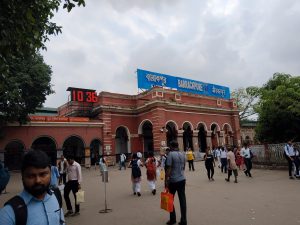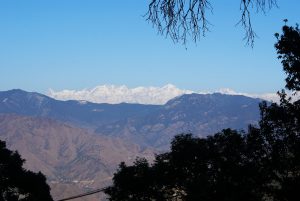
Rishikesh, in Uttarakhand, India, is famous for its spiritual, cultural, and adventure experiences. Nestled at the foothills of the Himalayas by the Ganges River, it attracts visitors looking for spiritual growth, yoga, and outdoor activities. Rishikesh, known as the “Yoga Capital of the World,” is renowned for its yoga ashrams and centers. It is reachable by road from major cities such as Delhi and Haridwar, has good train connections, and is a common stop for pilgrims traveling to the Char Dham pilgrimage sites: Yamunotri, Gangotri, Kedarnath, and Badrinath. The ideal time to visit Rishikesh is from September to November and February to April, when the weather is pleasant for outdoor activities, spiritual retreats, and exploring the natural beauty of the city.
Day 1- Explore the vibe of the city- Start your day with yoga at Parmarth Niketan or a well-known ashram and engage in meditation and spiritual discussions if offered. Visit the Beatles Ashram in the afternoon. The Beatles’ time at the ashram was significant for both their music and personal growth, leading to the creation of many songs that would later feature on the “White Album.” The ashram symbolizes the blend of Eastern spirituality and Western culture. Today, it is known for vibrant graffiti depicting The Beatles and their experiences in Rishikesh, adding an artistic element to the site. Established by Maharishi Mahesh Yogi for Transcendental Meditation, the abandoned ashram still attracts visitors seeking meditation and introspection due to its serene location near the Ganges. The ruins, surrounded by nature, offer a tranquil retreat for those looking for reflection. Finish your lunch at the famous Chotiwala restaurant with northern flavors. In the evening, relax by the Ganges and enjoy the serene environment. Consider a peaceful boat ride on the river to end your day on a calming note. The serene boat ride along the river provides a calming experience, enhanced by the gentle sounds of water and views of temples and ashrams. Passengers can observe pilgrims and priests performing Ganga Aarti and the vibrant life along the ghats, with a particularly strong spiritual atmosphere at dawn or sunset. The ride features sights of Rishikesh’s landmarks, including the Lakshman Jhula and Ram Jhula bridges, and can be arranged near Triveni Ghat or the Jhula areas.
Day 2- Time to get adventurous- Start your day with an exciting white-water rafting experience on the Ganges in Rishikesh, known for its diverse rapids suitable for both beginners and experienced rafters. The rapids range from easy Grade I to challenging Grade IV, with popular spots including Sweet Sixteen, Roller Coaster, Golf Course, and The Wall. The most favored route is from Shivpuri to Rishikesh, offering a blend of adventure and scenic views. Experienced guides accompany rafters to ensure safety, and it’s crucial to follow their instructions. The optimal times for rafting are from September to mid-November and March to early June, when river conditions are ideal. Packages often include additional activities like cliff jumping, body surfing, and beach camping. Rafting trips typically last between 2 to 5 hours based on the chosen route and rapids. Participants should wear comfortable, quick-drying clothes and secure footwear such as water shoes or sandals, and should avoid bringing valuables unless they have waterproof pouches. While rafting is usually safe, a basic level of fitness is needed. Non-swimmers can join but must inform the guides in advance. Post this thrilling experience of rafting head towards your favorite cafe like The Beatles Café, Ganga View Café, Little Buddha Café or Freedom Café for lunch. In the evening The Ganga Aarti at Parmarth Niketan is a spiritual evening event where bells and chants create a serene atmosphere as lamps are set afloat on the river.
Day 3- End it on a spiritual note- Early morning, head towards Neelkanth Mahadev temple. The Neelkanth Mahadev Temple, located at an altitude of 1,330 meters in Uttarakhand’s Pauri Garhwal district, is a significant shrine dedicated to Lord Shiva. Surrounded by beautiful forests, it offers breathtaking views of the valleys and mountains. According to Hindu mythology, the temple marks the site where Lord Shiva ingested poison during the churning of the ocean, which turned his throat blue, earning him the name Neelkanth. Devotees perform rituals such as offering water, milk, and bilva leaves to the Shivalinga and participating in the Abhishek ceremony. The temple is about 32 kilometers from Rishikesh, accessible by scenic drives with options like private taxis and shared jeeps. It offers a peaceful experience for both devotees and travelers. To experience delightful Italian flavor, visit A Tavola Con Te restaurant and savor freshly made pizzas straight out of the wood fire oven. After that, explore Lakshman Jhula (currently closed), Ram Jhula, and Janaki Jhula, renowned suspension bridges that provide beautiful views of the Ganges and nearby hills. Visitors can also explore nearby temples and ashrams, including Lakshman Temple and Swarg Ashram. In the evening visit Triveni Ghat to witness The Maha Aarti, a significant and spiritual evening ritual held daily on the banks of the Ganges River, attracting pilgrims and tourists who come to experience the devotion and energy of the event. Afterwards, visitors can explore local markets for souvenirs.
-Triparna







